Yamaha's top-of-the-line "hyper naked" motorcycle is wearing LEGO® Technic clothes. 42159 Yamaha MT-10 SP is the second 1:5 scale motorbike from The LEGO Group, but plenty more besides the manufacturer has changed on this successor. Overhauled gearbox pieces revolutionize shifting, while plenty of regular parts get a major aesthetic upgrade with better sprue mark positioning.
Itty bitty bits aside, the overall bike embodies "The Dark Side of Japan"—Yamaha's MT-10 SP catchphrase—with aggressive styling. Broad strokes of black and minimal fairings suit my taste in motorcycles, even if there are a few areas where I question Yamaha's choices.
Products in this article were provided by LEGO®; the author's opinions are their own.
LEGO® Technic 42159 Yamaha MT-10 SP
US$239.99/ £199.99/ 229.99€/ AU$349.99
1478 parts
1 August 2023
Please consider using our affiliate links, we may get a small commission if you purchase: Set 42159 on LEGO.com
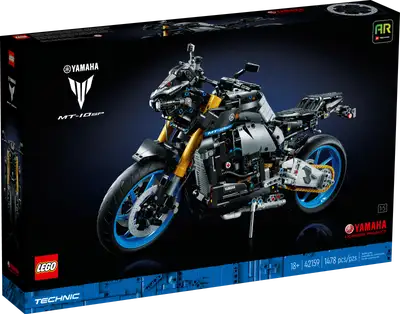
Between the engine, transmission, and suspension, there are a lot of mechanical details to be excited about. Before diving into the build and functions though, let's look at the new moulds which make the revamped transmission possible.
New elements
- 2x Technic Gear Stepper with 8 Tooth in Bright Yellow/ Yellow (6408181 | 2474)
- 2x Gear Shifter Fork in Bright Orange/ Orange (6447082 | 4159)
- 2x Technic Driving Ring 2L in Dark Stone Grey/ Dark Bluish Gray (6408180 | 2473)
- 1x Technic Gear 24 Tooth with Clutch on Both Sides in Bright Red/ Red (6408179 | 2471)
A smattering of new and unusual parts are included with the Yamaha MT-10 SP. Those orange shifter forks slide loosely via their axle holes while a vertical pin hole can be used to drive them along their tracks. The forks' semicircular opening is the same diameter as minifig heads, perfect for clamping down some cranial compression and making a fourth connection in addition to the loose axle holes and regular pin hole. Later down we'll see how towball pieces connect into those pin holes to carry force given by the new shifter drums.
The forks' tines are the same thickness as a thin Technic liftarm, which slot right into the groove around the new driving rings. That central groove is similar to previous driving rings which accommodate changeover and rotary catches (
6641 and
35188). The advantage to the new version are their reduction in size to a compact two modules long, and doubling of the amount of splines. More splines means less backlash, the only kind of play we don't want when playing with LEGO transmissions.
The clutch gear family grows with the red gear, adding a 24-tooth option to gearbox building. This might be less jaw-dropping than the other strange moulds, but it's still a welcome addition as it also helps in building compact gearboxes with more range.
Ultimately the stepper gear stands out as the most odd. It doesn't really fit into any existing parts family, similar to the orphaned
yellow differential gears introduced in 42143 Ferrari Daytona SP3. If anything, these are somewhat akin to the "splat" gear family since the spaces between the teeth teeth are stud sized. Kinda looks like a splat too, right?
Above I've explored the geometry, and with imperfect math the gear can be held in place with four studs with a half module between each as shown in the top-left. Further down we'll see how these are used to make a ratcheting shifter mechanism. The design of this gear seems intended to land pins or axles in the spaces between teeth, though the Yamaha transmission eschews that expectation entirely. Instead, an axle pushes each tooth perpendicularly. Since this part is so new and unusual, we'll likely see more techniques invented soon by MOCcers and TLG alike.
- 2x Gear Shifter with Groove in Medium Azure (6447081 | 4158)
Serving a similar function to the funky orange rotary shifter (35188), these new shifter drums are indented with a rounded groove, as wide as a towball and half a towball in depth. Eight positions are marked alphabetically to aid building and design, and the axle hole strangely doesn't go all the way through, but for a good reason. A center stop divides the central axle hole, each half of which is rotated 45 degrees from the other. That allows both drums to turn on the same axis but in different phases, meaning five different shifter fork position combinations can be achieved with two drums.
Updated moulds
Usually we skip over mould updates at New E, unless they make a difference like
the 2x2 SNOT plate in the Sonic Brickheadz. Today's mould update gives a big cosmetic improvement to LEGO Technic builders' best friends, liftarms.
Injection points for five liftarm lengths have been moved to between their pin holes, solving a decades-long issue of orienting them to keep the unsightly sprue marks hidden. That's only if you're as bothered by it as I am—after all, sprue marks are an avoidable issue
I've whined about more than once. Placing them in the most concealed location is always the right move, and one I'm thankful for.
3- through 13-module long beams have been updated, though somehow 9L got skipped and retains its mark on the smooth side of the beam. The first instances of the updated liftarms appeared in 42160 Audi RS Q e-tron, though this is the first time New Elementary has our hands on these beautified liftarms.
As a nearly comprehensive update to the most common liftarms, the 2x4 and 3x5 L-beams are similarly updated.
Recoloured elements
- Technic Panel Fairing #7 3L Very Small Smooth, Side A in Transparent Brown (6426591 | 2387)
- Technic Panel Fairing #8 3L Very Small Smooth, Side B in Transparent Brown (6426593 | 2389)
- Technic Panel Fairing #7 3L Very Small Smooth, Side A in Medium Stone Grey/ Light Bluish Gray (6438429 | 2387)
- Technic Panel Fairing #8 3L Very Small Smooth, Side B in Medium Stone Grey/ Light Bluish Gray (6438430 | 2389)
- Technic Panel Triangle 5 x 4 Right in Dark Stone Grey/ Dark Bluish Gray (6450241 | 80274)
- Technic Panel Triangle 5 x 4 Left in Dark Stone Grey/ Dark Bluish Gray (6450242 | 80278)
- Technic Panel Curved 5 x 7 Parallelogram Right in Dark Stone Grey/ Dark Bluish Gray (6450238 | 80268)
- Technic Panel Curved 5 x 7 Parallelogram Left in Dark Stone Grey/ Dark Bluish Gray (6450239 | 80267)
Even on a mostly-black motorbike, many triangle panels get recoloured in various shades of grey. These somewhat-new parts continue to flesh out their palettes, though one pair are using a recently outdated colour. The small translucent #7 and #8 panels, leftmost above, are the first triangle panels in a translucent colour, and only the fourth and fifth see-through Technic panels. Even with this novelty, these parts have been moulded in the old trans-brown instead of
this year's cool-toned update to trans-black.
Here's an old Trans-Brown windscreen to compare. The frosted finish on the triangles panels makes them look a little lighter, but they are certainly—and somewhat confusingly—
not the new trans-black colour.
- 2x Technic Steering Portal with 2 Pin Holes and 2 Axle Holes in Black (6416090 | 69636)
- 2x Technic Shock Absorber 18L with Internal Spring in Warm Gold/ Pearl Gold (6416662 | 69633)
- 1x Technic Shock Absorber 9L with Yellow Spring (6433367 | 79717c03)
- 2x Wheel 107.1 x 24 Motorcycle in Bright Blue/ Blue (6416089 | 71720)
No bespoke spokes were made for the Yamaha. These seven-spoke wheels perfectly match the other 1:5-scale bike, the real BMW M 1000 RR, while here they're just recoloured for the Yamaha set. It's likely with so many other new moulds introduced with this bike, making custom five-spoke rims for the MT-10 SP wasn't in the cards. Still, knowing this shape is exactly what's seen on the real BMW Motorrad makes them feel somewhat out-of-place on the Yamaha.
Rare parts
- 2x Brake Disc 8 x 8 with Black Center Pattern in Medium Stone Grey/ Light Bluish Gray (6331551 | 71711pat0001)
- 1x Tyre Motorcycle Racing Tread, Narrow in Black (6330607 | 71721)
- 1x Tyre Motorcycle Racing Tread in Black (6330608 | 71722)
Borrowing more from the groundwork laid by last year's 1:5 scale BMW motorcycle, large front brake rotors and tires return. Putting these pieces to use in anything other than a gigantic vehicle would take work, but it can be done. I'll always appreciate the level of detail applied to the front brake rotors, with actual holes and lightweight dual-moulding mimicking the most important parts of a beefy sportbike.
- 2x Technic Panel 5 x 11 x 1 Tapered in Medium Stone Grey/ Light Bluish Gray (6327007 | 18945)
- 3x Technic Panel Fairing #9 Medium Triangle Smooth in Black (6426603 | 2395)
- 3x Technic Panel Fairing #10 Medium Triangle Smooth in Black (6426604 | 2403)
- 2x Technic Panel Fairing 2 x 3 x 1 #3 Angled in Dark Stone Grey/ Dark Bluish Gray (6426611 | 2457)
- 1x Technic Panel Triangle 5 x 4 Right in Black (6400129 | 80274)
- 1x Technic Panel Triangle 5 x 4 Left in Black (6400130 | 80278)
- 1x Technic Panel Curved 5 x 7 Parallelogram Right in Black (6380030 | 80268)
- 1x Technic Panel Curved 5 x 7 Parallelogram Left in Black (6380021 | 80267)
Triangle panels are popular lately. Most of these parts have been introduced in the last two years, for example the DBG angled panel was introduced in
this year's 42156 Peugeot 9X8 Le Mans Hybrid Hypercar. The BMW M 1000 RR's influence is inescapable, as it's the only other set to include the leftmost long 5x11 tapered panels in LBG. In both bikes those panels form the swingarm.
- 7x Technic Beam 2 x 3 L-Shape with Quarter Ellipse Thick in Medium Stone Grey/ Light Bluish Gray (6361459 | 71708)
- 2x Technic Panel Curved 7 x 3 with 2 Pin Holes through Panel Surface in Medium Stone Grey/ Light Bluish Gray (6257136 | 24119)
Another popular shape as of late is the 2x3 quarter ellipse family. Both parts in LBG are common to
42126 Ford F-150 Raptor while the 7x3 panel is also in the BMW Motorrad and Peugeot 9X8 Le Mans vehicles.
- 4x Technic Beam 3 x 5 L-Shape with Alternating Holes in Black (6408182 | 2477)
- 4x Technic Beam 1 x 7 Thick with Alternating Holes in Dark Stone Grey/ Dark Bluish Gray (6432397 | 2391)
Another new part family which continues to grow are flip-flop liftarms. These relatively shorter members each are seen in just three sets; we first saw the DBG 1x7 flip-flop beams in my examination of
42154 2022 Ford GT.
- Tile Special 4 x 8 Inverted in Black (6448634 | 83496)
- Wedge Curved 4 x 4 No Top Studs in Medium Stone Grey/ Light Bluish Gray (6335830 | 47753)
LEGO Technic and LEGO® System parts live together in harmony, which is why no big LEGO Technic set is complete without some studded parts. A couple in this set are rare: the largest black inverted tile is seen just elsewhere in the LEGO® Friends theme, while the 4x4 LBG slope is seen across licensed themes and in
80044 Monkie Kid's Team Hideout.
Sticker sheet
I chose to leave all the stickers on their sheet. That black inverted tile up above gets the "Yamaha Revs Your Heart" sticker, but the manufacturer branding alone doesn't compel me enough to justify decorating a rare inverted tile. That decision would be harder if I was passing up a UCS-style spec plaque. Yamaha touts specs like their crossplane engine design and torquey Masters of Torque credentials (hence the MT in MT-10 SP) throughout the LEGO Technic AR app—that kind of info would perfectly fill a UCS-style plaque. I've often compared this set to 42130 BMW M 1000 RR, but the Beemer has a detail-filled plaque with delicious stats for vehicle geeks, where the Yamaha does not.
It's not the just the inverted tile I wanted to keep un-stickered. Half of the stickers go on parts deemed rare above, and after all, most of the bike is undecorated unlike the BMW Motorrad. The visual design of the real Yamaha gets through just fine without stickers.
 |
| ©2023 The LEGO Group |
The build and functions

The base at the bottom is where that Yamaha branding would go, had I put it on. Sitting up there, wheels hovering above the ground, puts the bike up for inspection. Few LEGO vehicles are ever made as large as 1:5 scale; thanks to the suitability of motorcycles for this scale we get to see this one in extra detail.
I'm especially drawn to the front brake rotors—big discs flanking a wheel like that lets you know this bike means business. The rotors are specialized elements rather than a built feature which may draw ire from some people, but this level of detail can only be achieved with dual moulding and a ton of tiny holes. A more general element, a Silver Metallic/ Flat Silver Flexible Zipline, 22L with 2 Connectors (6210590 | 27965) forms a detail I equally like. It's a brake line, connected from the brake cylinder on the handlebars to the brake calipers on each wheel.
Sportbikes often employ curved radiators, the subtle arcs of which are hard to recreate within limited space. I prefer
42130 BMW Motorrad M 1000 RR's solution. That same design could have been modified to match the actual Yamaha MT-10 SP's all-horizontal radiator flutes, which are disrupted perpendicularly here by cheese graters.
Oh, and the fake air scoops... prepare for some Ya-drama-ha. MT-10 owners and critics will deride the real-life bike's two bulbous pods poking out from behind the gold shocks and below the gas tank. These would receive blue "MT-10 SP" stickers on the LEGO Technic version had I applied them.
 |
| © 2022 Joseph Agustin |
They're styled like air intakes, but are in fact sealed compartments which pass no air, just wiring and fuses on the real bike. The wiring prevents removal of the faux breathing holes, leaving some owners frustrated when they'd like to customize. Of course, nearly every vehicle sold these days have oversized façade grilles, but at least it's easier to remove them in LEGO form if imitation intake irritates you.
One area of the build is definitely not an imitation: the 3-speed transmission is functional. It transmits rotation between the rear wheel and the engine at three different gear ratios, plus it has a neutral position. The possibilities for LEGO Technic transmissions have grown immensely in recent years, and the new shifter drums and forks take that a step further.
The transmission alone shows the function of the orange shifter forks and how they interface with the grey 2L dog clutches. With the orange forks centered, they touch no gears—that's neutral. As the drums rotate and move the forks, one of the red or green clutch gears are engaged at a time. The smallest gear "runs" the rear wheel fastest, while the largest gear provides more torque but less speed.
With the engine and shifter added, you can see the ratcheting gear selector mechanism in action. The foot shifter is added later to the tan axle at bottom center which moves the grey parts up and down. This rotates the drum assembly via the eight-tooth stepper gear one-eighth of a rotation. The red spring-loaded liftarm presses down (lifted out of the way above), using two teeth of the far yellow gear as a flat to keep the clutch fully engaged and correctly positioned.
Ready for some engine internals pedantry? Yamaha is proud of something which makes their high-end motorcycle's engines different from other four-cylinder inlines. That would be a crossplane crankshaft, which isn't what's built here.
With the engine in place above the transmission, we see two pistons at the tops of their strokes—level with the top of the grey cylinders. Only one piston would be fully up with a crossplane crankshaft, since that design has the four pistons spaced evenly though the rotation. Official MT-10 marketing, the LEGO instruction manual, and the LEGO Technic AR app all promote the benefits of a crossplane crankshaft, and that simply isn't what's built here.
LEGO Technic engines center around the
crankshaft (2853) and
crankshaft center (2854) pieces. Their axle connections are inline and no offset or angled alternatives exists, therefore the most compact LEGO Technic engines possible all utilize flatplane cranks. It
is possible to build a crossplane crank with those parts, but it adds at least two modules of engine length to a four-cylinder design. Evidently keeping the engine length at eight modules was more important than crankshaft accuracy.
That being said, once the bike is built, I can ignore the crankshaft inaccuracies and appreciate the outer bodywork and some bits visible within. Long gone are the days of LEGO Technic sets built only of sparse frames laying their functions bare, but some of the transmission can be seen through gaps between the dark grey panels. The red ball indicator, spring, and rightmost yellow gear are slightly visible. Want a better look? It's easy to yoink those DBG panels off and strip this hyper naked bike a layer further.
From left to right, the gear indicator moves through 1st, neutral, 2nd, and 3rd gears. Here the spring retainer is in place, firmly pressed against two teeth of the gear. Typically motorbikes take a half-click to go up to neutral from first, but implementing that degree of detail isn't necessary. While we've got the side panels off, let's look at the other side.
Lots of subtle angles have been carefully implemented by designer Lars Thygesen. The slight forward tilt of the power unit puts liftarms in close proximity, some of which would interfere if not smartly designed. Look above the azure shifting drums and engine - a black 1x13 gear rack (
64781) is used in place of a standard 1x13 to tie the left and right sides of the engine top together. The toothed rack serves no geared function but it is slightly thinner, allowing it to fit where a full-fat 13L liftarm wouldn't fit under the grey frame just above.
To get views like this without dismantling the Yamaha, the LEGO Technic AR app offers a thorough peek inside with a modern smartphone. It's similar to the
augmented reality shown by the LEGO Technic Control+ app we looked at with 42129 Mercedes-Benz Zetros 4x4, though this half-gigabyte app is meant for LEGO Technic models without remote control.
LEGO Technic AR has an astounding amount of features. It's one part unrestrained Yamaha branding and one part mechanical education, all enough to get my phone hot and bike even more naked. Scanning the bike ushers in a nighttime high-octane video of the real Yamaha MT-10 SP, followed by an equally gritty, neo-Tokyoesque AR intro. The Unity-based app's thorough tutorials cover every aspect of the bike, from its "air intakes" to the black and silver paint. If you have a large room, you can digitally plop down a life-sized Yamaha MT-10 SP and then swap it out for the LEGO Technic version at the same scale.
I dove in for the mechanical features and LEGO Technic AR did not disappoint. Detailed views of the powertrain break down the function of each component, showing off fancy new transmission pieces while teaching users how horsepower moves from piston to pavement. This again mentions a crossplane crankshaft—which we know the model doesn't truly have—but I've got to suspend my disbelief somewhere. The whole software experience was bug-free, unfettered by logins and intrusive offers, and responsive, which are reasons enough to recommend it.
There are limitations, of course. You'll need a fairly recent smartphone, and even then the app's storage and battery usage are a bit high. There's no way to explore without enabling AR, so you'll need the bike in front of you and fully assembled. It also requires a decent amount of physical space to orbit the model with information onscreen. The bike needs to be stationary on the display stand too, so physical play and AR can hardly overlap.
Back in the physical world, I found myself using the kickstand much more than the included black display stand anyway. Playing with such a functional bike is better than displaying it stationary. Real motorbike controls are all represented beyond the functional shifter I'm obsessed with. Nonfunctional but still present are the hydraulic systems: clutch and front brake levers, brake fluid cylinder and lines, and rear brake pedal. Of course, those newly gilded shock absorbers add front and rear suspension to the Yamaha.
If there's one thing designer Thygesen got right, it's the cold stare this Yamaha radiates—with comic relief provided by minifig-scale barrels for headlight housings. But a mean mug isn't the only thing this massive 1:5-scale model has going for it.
New parts are enough to get mechanical MOCcers excited, and if you prefer to keep the model built, the functions are a delight to explore. Between physical exploration and digging in digitally with the LEGO Technic AR app, this two-wheeler is fascinating. A whole new way of building transmissions has been unveiled, and the rest of the bike puts LEGO Technic fundamentals on full display. Some re-used parts from the first 1:5-scale LEGO Technic motorcycle can be forgiven with all the other new parts included, and Yamaha's favourite features on their MT-10 SP are mostly accurately recreated in LEGO form.
Looking to display 42159 Yamaha MT-10 SP on your shelf or put its parts to use in your mechanical MOCs? Consider using New Elementary's affiliate link, we may earn a commission.
Set 42159 on LEGO.com
READ MORE: New parts in LEGO® Marvel™ 76269 Avengers Tower, plus a MOC by Thomas Jenkins
Help New Elementary keep publishing articles like this. Become a Patron!
A huge thank you to all our patrons for your support, especially our 'Vibrant Coral' tier: London AFOLs, Antonio Serra, Beyond the Brick, Huw Millington, Big B Bricks, Dave Schefcik, David and Breda Fennell, Gerald Lasser, Baixo LMmodels, Sue Ann Barber and Trevor Clark, Markus Rollbühler, Elspeth De Montes, Megan Lum, Andy Price, Chuck Hagenbuch, Jf, Wayne R. Tyler, Daniel Church, Lukas Kurth (StoneWars) and Timo Luehnen! You folks are just the cutest little baby bows.
LEGO® Shop at Home
USA: FREE SHIPPING every day on orders over $35!
UK: Free delivery when you spend £50 or more at LEGO!
Australia:
Discover the latest promotions and offers on LEGO.com
All text and images are © New Elementary unless otherwise attributed.



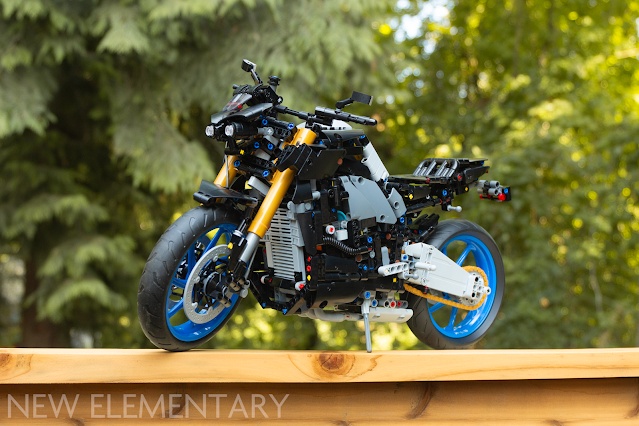
















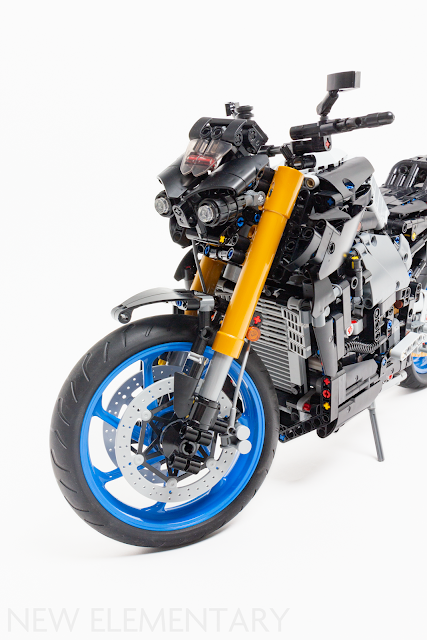



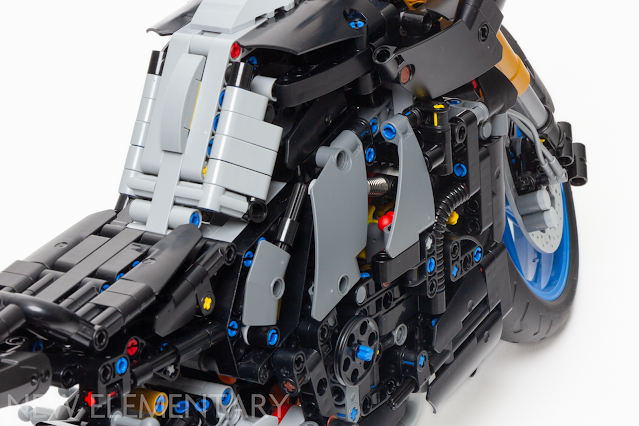



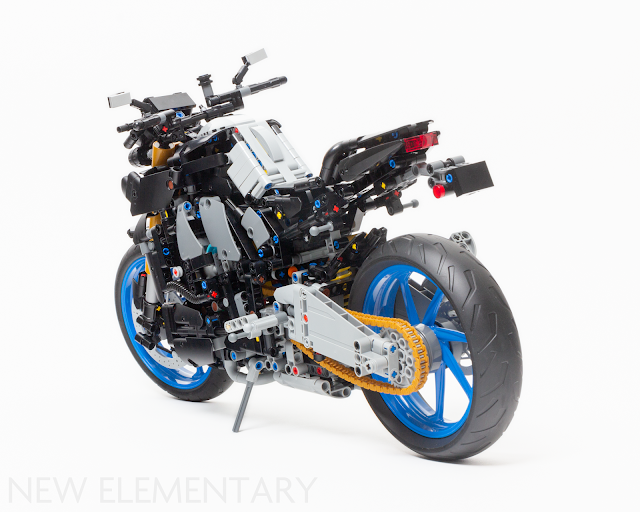
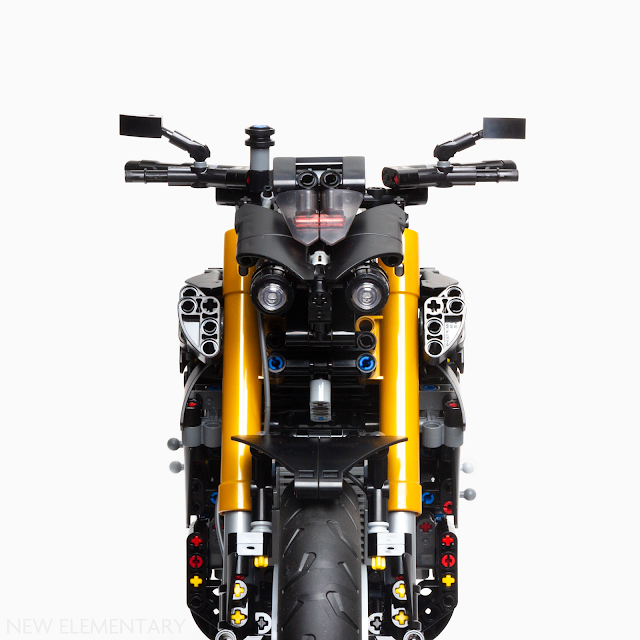
Thanks for this review! I feel like those shifter parts could be around for a while, seeing as so many modern cars use paddle shifters, which when translated to Lego function as ratchet shifters. I'm not sure what solution was used for the Bugatti and other modern Lego supercars, but I presume these parts are an upgrade.
ReplyDeleteThe Technic supercars tend to use the rotary changeover catch (35188) which move the dog clutches directly rather than this solution, which has similarities but adds a fork in the middle. These certainly feel smoother.
Deletedoes the the yellow stepper gear geometry mean it could mesh well as a sprocket for a chain made of liftarms? I've been experimenting with that for a while now... here's an early version of it https://www.youtube.com/shorts/FLf6JVsV_Lg
ReplyDelete